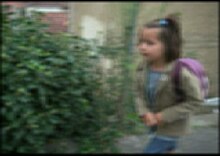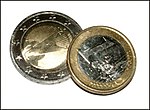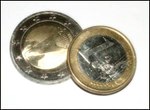Blur
As blur the conscious change is a photos referred to in the drawing or the contrast (the image) is reduced. The result of this composition is a blurring of the image or certain parts of the image.
features
Softening a photo is a special type of contrast change .
From a technical point of view, the contrast is reduced because there are low-contrast areas. This reduction in contrast can be used in a very differentiated manner
- in certain image areas,
- for certain colors,
- in selected brightness areas or
- a combination of the above
From a design point of view, this reduction in contrast represents a stylization of local image areas and therefore acts as a differentiation from other image information. This stylization increases the perception of desired image details and therefore represents a special - creative - increase in contrast.
Demarcation
Blurring is a deliberately created process of changing the image (to reduce the drawing) and thus something different from the visibility of blurring . Blurring is only a measure for assessing the quality of images , while blurring is a means of staged photography to change the image's message.
Blurring is a change in the image message with the help of technical means. The aesthetic quality of this change is known as bokeh . A bokeh is only an aesthetic term, not a measure of the strength or differentiation of a soft focus.
variants
There are many ways to blur an image.
- The soft focus before the image is saved. The methods used are independent of the type of image storage (film, file). The following can be mentioned as examples:
- The influence of light (example: diffuse light )
- The use of effect filters (example: effect filters ).
- The conscious use of lenses ( defocusing ).
- "Home remedies" like petroleum jelly (or skin oil from the nasal fold) on a filter in front of the lens; nylon stockings stretched over the lens (different effects due to black, white or brown)
- The soft focus after saving the image.
- The blurring of an analog image can essentially be done through the correct use of effect filters and lenses (in the enlarger ).
- Numerous software solutions can be used to soften digital images .
The automatic optimization process of large photo laboratories occupies a special position. There is a special transparent pane in the light shaft between the film and the photo paper. This transparent pane can be partially blackened by electricity. This blackening always creates a soft image of the photo. With the help of this process, all photos produced in large laboratories have been optimized since the beginning of the 1990s .
Soft focus lenses
The lenses used for soft focus are called soft focus . In some epochs of photography, such as at the beginning of the 20th century, this was seen as a conscious departure from the naturalistic representation of meticulously precise and sharp images. Various special lenses for this purpose are offered by the industry today.
Examples of soft focus lenses are:
- Rodenstock Imagon lenses and lens heads with interchangeable screen apertures (different focal lengths for different image formats)
- Sima 2 / 100mm lens with interchangeable screen apertures
- Minolta Varisoft lens with continuously variable soft focus (Minolta 2.8 / 85mm Varisoft)
- Minolta Soft Focus lens with continuously variable soft focus (Minolta AF 2.8 / 100mm Soft Focus)
- Canon soft focus lens with two levels of soft focus (can be switched off) (Canon EF 135mm 1: 2.8 soft focus)
- Seibold's Dreamagon lens with slit segment diaphragm (4 / 90mm)
Gaussian soft focus
A typical software solution for the soft focus of digital photos is the Gaussian soft focus with the help of the Gaussian filter . The name is based on the "Gaussian" normal distribution , which was developed by Johann Carl Friedrich Gauß .
- Comparison between blur, sharpness and soft focus
application
A soft focus lens or a soft focus filter used in classic photography creates a sharp image on which a portion of blurring is superimposed. As a result, the image, which is still perceived as sharp, appears romantic and dreamlike. Such effects are popular in portrait photography , for example , as large-pored skin appears much smoother.
There are also soft focus filters that only capture two-dimensional objects, but leave the image edges unchanged, so-called despeckle or median filters .
Digital soft focus is a low-pass filter . Small structures (the "drawing") are filtered out. This is why blurring can also be used when halftoning is to be removed.
Softening is often used in portrait photography , whereby the eyes are left out for the purpose of softening, especially during digital post-processing, as these should always be in focus in portraits. Soft focus is also used in nude photography . In landscape photography , on the other hand, blurring is usually not used.
Web links
Individual evidence
- ↑ Example: Removal of engraving lines ( memento of March 10, 2010 in the Internet Archive ) for the comparison of larger structures in a wood engraving (1876, Henry Holiday) and in an etching (1566–1568, Markus Gheeraerts the Elder).









